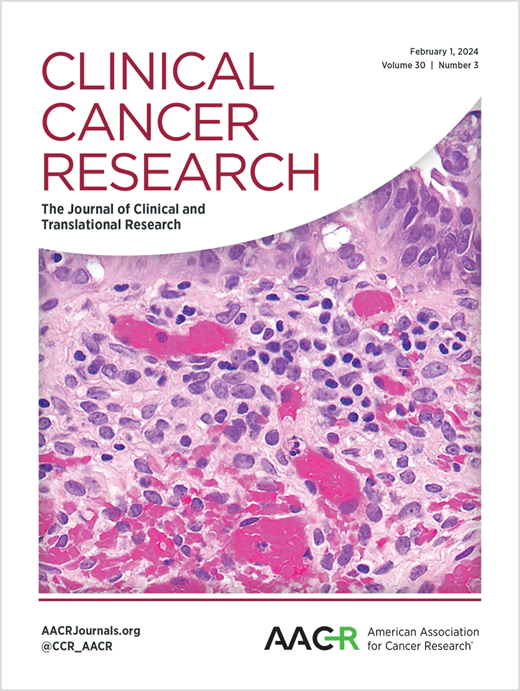肿瘤基因组图谱分子分类系统在食管胃癌中的临床意义
IF 10
1区 医学
Q1 ONCOLOGY
引用次数: 0
摘要
目的:癌症基因组图谱(TCGA)项目定义了四种不同的食管胃腺癌分子亚型:微卫星不稳定性(MSI)、eb病毒相关(EBV)、基因组稳定性(GS)和染色体不稳定性(CIN)。然而,分子亚型与临床结果之间的关联尚未得到明确证实。由于缺乏可操作的生物标志物,我们研究了TCGA分类系统的临床相关性。实验设计:在2014年至2023年期间,我们使用Memorial Sloan Kettering-IMPACT测定法对所有食管胃腺癌患者进行了前瞻性下一代测序。我们根据TCGA方法对所有肿瘤进行分类,并将分子亚型与高质量的临床病理数据相关联。结果:1438例患者中,CIN 941例,GS 344例,MSI 103例,EBV肿瘤50例。考虑到临床分期和肿瘤分级,分子分类与总体癌症特异性生存独立相关(P <;Cox多变量分析0.001)。此外,基因组特征、患者人口统计学、对新辅助治疗的病理反应、复发模式和转移性器官倾向因分子亚型而有显著差异。尽管大多数食管远端和胃食管交界处肿瘤为CIN,但与TCGA相比,高达25%的肿瘤包括GS、MSI或EBV亚型。随机森林机器学习表明,分子亚型在预测治疗反应方面比肿瘤位置更有影响力。结论:分子分类是独立的预后,可能需要纳入未来的分期和治疗指南。常规分子谱分析在临床上是可行的,可以在患者的管理中发挥作用,帮助指导肿瘤部位的适当治疗选择和临床试验的入组。本文章由计算机程序翻译,如有差异,请以英文原文为准。
Clinical Implications of The Cancer Genome Atlas Molecular Classification System in Esophagogastric Cancer
Purpose: The Cancer Genome Atlas (TCGA) project defined four distinct molecular subtypes of esophagogastric adenocarcinoma: microsatellite instable (MSI), Epstein–Barr virus (EBV)–associated, genomically stable (GS), and chromosomally instable (CIN). However, an association between molecular subtypes and clinical outcomes has not been clearly demonstrated. Given few actionable biomarkers, we investigated the clinical relevance of TCGA classification system. Experimental Design: We identified all patients with esophagogastric adenocarcinoma whose tumors underwent prospective next-generation sequencing using the Memorial Sloan Kettering–IMPACT assay from 2014 to 2023. We classified all tumors in accordance with TCGA methodology and correlated molecular subtypes with high-quality clinicopathologic data. Results: Among 1,438 included patients, 941 had CIN, 344 had GS, 103 had MSI, and 50 had EBV tumors. Accounting for the clinical stage and tumor grade, molecular classification was independently associated with overall cancer-specific survival (P < 0.001) on Cox multivariable analysis. Furthermore, genomic signatures, patient demographics, pathologic responses to neoadjuvant therapy, patterns of recurrence, and metastatic organotropism differed significantly by molecular subtype. Although most distal esophageal and gastroesophageal junction tumors were CIN, up to 25% of these included GS, MSI, or EBV subtypes in contrast to TCGA. Random forest machine learning demonstrated that the molecular subtype is more influential in predicting response to treatment than tumor location. Conclusions: Molecular classification is independently prognostic and may warrant inclusion in future staging and treatment guidelines. Routine molecular profiling is clinically feasible and may play a role in the management of patients to help guide appropriate treatment selection and clinical trial enrollment in the place of tumor location.
求助全文
通过发布文献求助,成功后即可免费获取论文全文。
去求助
来源期刊

Clinical Cancer Research
医学-肿瘤学
CiteScore
20.10
自引率
1.70%
发文量
1207
审稿时长
2.1 months
期刊介绍:
Clinical Cancer Research is a journal focusing on groundbreaking research in cancer, specifically in the areas where the laboratory and the clinic intersect. Our primary interest lies in clinical trials that investigate novel treatments, accompanied by research on pharmacology, molecular alterations, and biomarkers that can predict response or resistance to these treatments. Furthermore, we prioritize laboratory and animal studies that explore new drugs and targeted agents with the potential to advance to clinical trials. We also encourage research on targetable mechanisms of cancer development, progression, and metastasis.
 求助内容:
求助内容: 应助结果提醒方式:
应助结果提醒方式:


